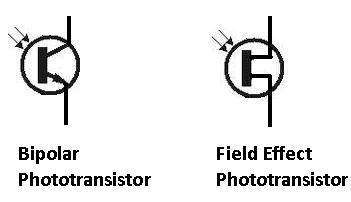What are Phototransistors?

Phototransistors are light-sensitive transistors.
A common type of phototransistor resembles a bipolar transistor with its base lead removed and replaced with a light-sensitive area. This is why a phototransistor has only 2 terminals instead of the usual 3. When this surface area is kept dark, the device is off. Practically, no current flows from the collector to emitter region. However, when the light-sensitive region is exposed to light, a small base current is generated that controls a much larger collector-to-emitter current.
Just like regular transistors, phototransistors can be both bipolar or field effect transistors. Field-effect phototransistors (photoFETs) are light-sensitive field-effect transistors. Unlike photobipolar transistors, photoFETs use light to generate a gate voltage that is used to control a drain-source current. PhotoFETs are extremely sensitive to variations in light and are more fragile, electrically speaking, than bipolar phototransistors.
These are the schematic symbols for photodiodes:
